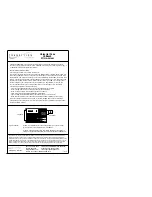
5-6
The problem is that the two systems use the same spectrum,
making it impossible to distinguish between the two with one
instrument.
The recommended method for these systems is to first sweep the
forward portion of the network, then move the transmitter out to the
furthest extremity and sweep the reverse portion.
5.2 REVERSE SWEEP SETUP
If the frequency bands of the active services are known, the reverse
channel plan can be built with a 250 kHz resolution. Then the active
service frequencies can be quickly edited out. Alternatively, if there
is any uncertainty about the frequency bands occupied by the active
services, the Model 3ST or Model 3HRV reverse sweep receiver may
be used to collect this information in the spectrum analyzer mode
with a 50 MHz span and a center frequency of 30 MHz. A 'max-held'
spectrum over an extended period can be analyzed to determine
which frequencies in the reverse path contain active services so as to
avoid interference.















































